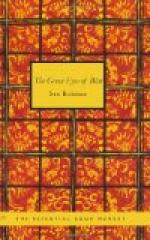Gatton nodded.
“I think, Mr. Addison,” he said, “I will proceed immediately to Bow Street, where she has been taken to be interrogated. Will you come with me or are you otherwise engaged?”
I hesitated ere I replied:
“I do not particularly want to confront this woman, but I should be much indebted if you could let me know the result of your examination.”
“I shall do that without fail,” said Gatton, “and some time to-day I should be obliged if you could provide me with the facts concerning the little cat-images which you said you had in your possession.”
“Certainly,” I agreed. “You are still of the opinion that the mark upon the crate and the image of the cat-woman have an important bearing upon the crime?”
“I don’t doubt it,” was the reply. “If the photograph clew is a false one, the cat clew is a true one and one to be followed up. Perhaps,” he added, “it would be as well if you returned now and looked out the points which you think would be of interest, as when I come I may not have long to stay.”
“I will do so,” I said, “although I think I can lay my hands upon the material almost immediately.”
Accordingly Gatton set off with the detective who had brought the news of Marie’s arrest and I, turning in the opposite direction, proceeded towards my cottage in such a state of mental tumult respecting what the end of all this would be and what it might mean for Isobel, that I found myself unable to think connectedly; and needless to say I failed to conjure up by any stretch of the imagination a theory which could cover this amazing and terrible sequence of events.
CHAPTER VII
THE CAT OF BUBASTIS
“She belongs to the innumerable family of cats which suddenly came forth from the ruins of Tell Bastah in 1878,” I wrote, Sir Gaston Maspero’s “Egyptian Art” lying before me on the table, “and were in a few years scattered over the whole world.”
“She is Bast, a goddess of good family, the worship of whom flourished especially in the east of the delta, and she is very often drawn or named on the monuments, although they do not tell us enough of her myths or her origin. She was allied or related to the Sun, and was now said to be his sister or wife, now his daughter. She sometimes filled a gracious and beneficent role, protecting men against contagious diseases or evil spirits, keeping them off by the music of her sistrum: she had also her hours of treacherous perversity, during which she played with her victim as with a mouse, before finishing him off with a blow of her claws. She dwelt by preference in the city that bore her name, Poubastit, the Bubastis of classical writers. Her temple, at which Cheops and Chephren had worked while building their pyramids, was rebuilt by the Pharaohs of the 22nd Dynasty, enlarged by those of the 26th; when Herodotus visited it in the middle of the fifth century B.C. he considered it one of the most remarkable he had seen in the parts of Egypt through which he had traveled.




